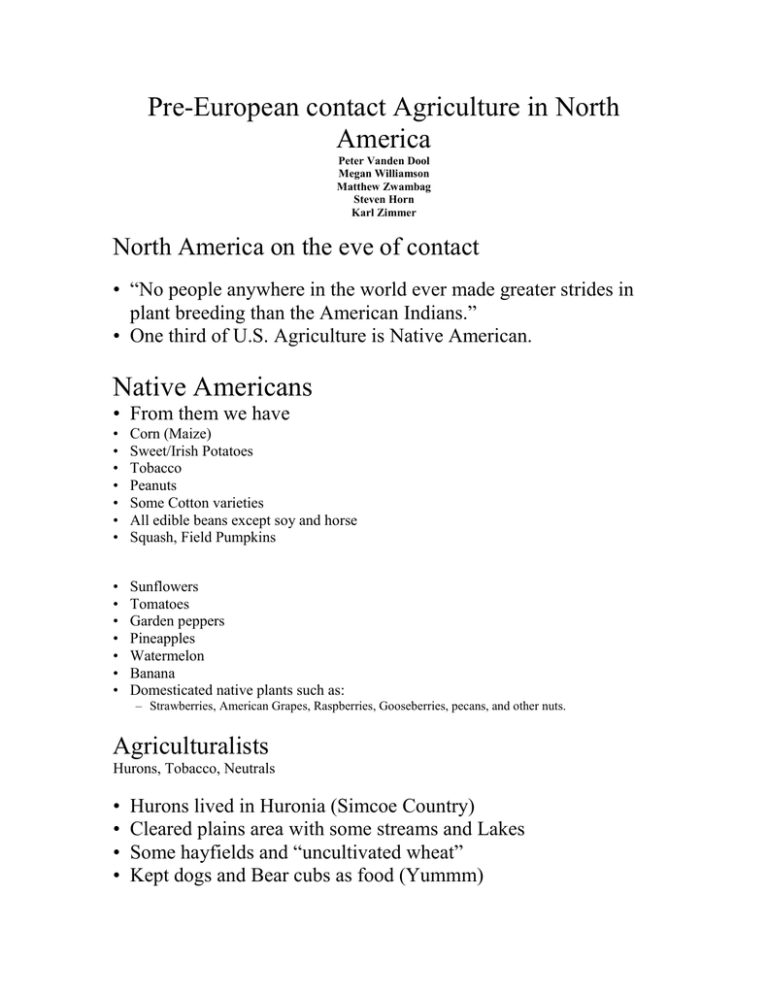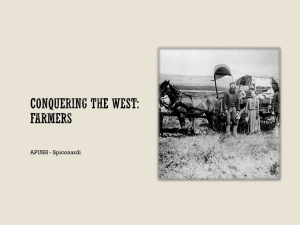Pre-European contact Agriculture in North America
advertisement

Pre-European contact Agriculture in North America Peter Vanden Dool Megan Williamson Matthew Zwambag Steven Horn Karl Zimmer North America on the eve of contact • “No people anywhere in the world ever made greater strides in plant breeding than the American Indians.” • One third of U.S. Agriculture is Native American. Native Americans • From them we have • • • • • • • Corn (Maize) Sweet/Irish Potatoes Tobacco Peanuts Some Cotton varieties All edible beans except soy and horse Squash, Field Pumpkins • • • • • • • Sunflowers Tomatoes Garden peppers Pineapples Watermelon Banana Domesticated native plants such as: – Strawberries, American Grapes, Raspberries, Gooseberries, pecans, and other nuts. Agriculturalists Hurons, Tobacco, Neutrals • • • • Hurons lived in Huronia (Simcoe Country) Cleared plains area with some streams and Lakes Some hayfields and “uncultivated wheat” Kept dogs and Bear cubs as food (Yummm) • Main crops: Maize beans and Squash. • Also grew tobacco and sunflowers • Mostly Slash and burn Agriculture – Cleared the land by cutting trees to stumps (2’-3’) then burned the branches around the stump to kill it and remove the roots. – 9-10 grains were placed in hills, sorted by size and placed in water and herbs before planting. • Wild fruits with maple for sweetening supplemented their diet. Wild rice was their staple. • Tobaccos lived Southwest of the Hurons and shockingly raised large quantities of Tobacco. • Neutrals were located north of lake Erie. Nomads • • • • They roamed from the Churchill river to the Treeless Tundra They traveled mostly on foot and women moved the camp. Northern peoples followed the Caribou which provided food and clothing. The Plains people followed the Bison. There is some evidence that these people also practiced agriculture. (Garden areas) Likely planted, moved on and returned for harvest North American Agriculture • Agriculture is a comprehensive geographical topic • Geographers have focused strongly on Latin American • North American agricultural knowledge is based mainly through archeological work through the 19th century on. Agriculture is a comprehensive geographical topic that includes modification of biological and physical components. It is dynamic in that it is continuing to evolve. Geographers have focused strongly on Latin American. They examined pre-industrial tools and techniques used. North American agricultural knowledge is based mainly through archeological work through the 19th century on. Few geographical studies on the north American agriculture implies shortcomings because geographers are skilled at interpreting spatial components, agro ecology, and land use. Causes of Lack of Information • Data is a byproduct of other research • Evidence of agriculture is based on plant remains and pollen of cultigens • Studies done on how agriculture fits into social and economic structures of culture • Ethnographical analogs from Native Americans were taken uncritically • Few syntheses have been attempted -data is a byproduct of other research. This implies that there is not much research specifically on food production. -Evidence of agriculture is based on plant remains and pollen of cultigens. This focuses on crops instead of the land and techniques producing them. -studies done on how agriculture fits into social and economic structures of culture. They didn’t focus on the human environment and spatial implications. -Ethnographical analogs from Native Americans were taken uncritically, which could mean their data is faulty. -Few syntheses have been attempted. Information Shortcomings • Explorers present biased accounts of what they see • Some indigenous people were using tools and techniques of Europeans before being encountered • Some places were visited more often than others By looking at data from explorers and archaeologists in parallel a fairly good idea of the pre-contact agriculture is formed but there are shortcomings in the explanations. Information shortcomings: explorers present biased accounts of what they see. Some indigenous people were using tools and techniques of Europeans before being encountered. For example, some natives could pass on European methods inland to other tribes before the Europeans explore inland more. Some places were visited more often than others. This is often because the most visited places have intriguing agricultural techniques. And so, there are several sources to corroborate details. The Southwest Before Contact: Intensive Intensive: requires considerable labor or substantial landscape modification, because the biophysical environments are so harsh and rugged there is little land suitable for agriculture Two Land Types • • Floodplains of low-lying desert streams Floodplains: deep fertile soils --- highly localized soils fertile due to deposition of sediments when flooding occurs due to vegetation slowing water flows so sediments fall out of solution Upland slopes uplands slopes: where rainfall is more sufficient but soils are thin and of poor quality more rainfall due to orthographic lifting To increase suitability and productivity of these areas: - irrigation, terraces, check dams Irrigation • • • • 1st Canal 130 A.D. Natives Irrigating at time of Contact Not across whole region Two main: – Eastern Sonora – Northern New Mexico Important for Pima, Hopi, and Zuni Early spanish explorers reported two main areas: Sonora, New Mexico Baltasar de Obregon (chronicler) wrote in 1565 people of the valleys of sonora had their plantations are well provided with canals used for irrigating them. Antonio de Espejo reported in 1582 people of the Rio Grande pueblos had fields planted with corn, beans, calabashes, and tobacco in abundance. These crops are seasonal, dependent on rainfall, or they are irrigated by means of good ditches Pueblo: the communal dwelling of an Indian village of Arizona, New Mexico, and adjacent areas consisting of contiguous flat-roofed stone or adobe houses in groups sometimes several stories high b : an Indian village of the southwestern U.S. 2 capitalized : a member of a group of Indian peoples of the southwestern U.S. • New Mexican pueblos – Growing Season 120 –140 days – Single Crop per year growing season 120 – 140 depending on locale -summer rainy season, irrigation during dry spells • Eastern Sonora – Growing Season 220 –260 days – Two crops per year --Sonora growing season 220 – 260 days (twice as long) -Annual precip July to September -Hardly any rain from March through June -Later crop used some irrigation (during dry spells) -Early crop dependent on it -Double cropping sustained a large number of people -Due to dependence on canals a social organization was required, I suppose due to every one needing to work together rather than alone -More elaborate social organization than pueblos of new Mexico -Jesuits introduced the social organization, which led in the end to the loss of the Sonora Indians identity because social unrest occurred and became assimilated by the Jesuits. New Mexico pueblo Indians identity remains today Irrigation Canals • Functional Complexity varied • Small to Large • Short term to Long term • Correlation between size and sustainability Hohokam people of the Salt and Gila River valleys distinguished themselves by developing some large canal irrigation systems. (10m x 4m deep) and some up to 30 km long -Not all canals used at the same time -Many times created new canals rather than do maintenance on existing ones -However evidence on soil survey maps of accumulations of sediment around historic canal sites Hohokam struggled constantly to manage their water resources but eventually lost the battle b/c there culture collapsed Other canals systems throughout the region usually rarely exceeded 10 km in length, 2m wide and 0.5 m in depth and branched that provided water for a maximum of a few hundred hectares These systems were very durable and many of the ones in New Mexico remained in use for several centuries and those in the Sonora remained useable for 700 years Irrigation in Southern Alberta Information from: www.uleth.ca/vft/Oldman_River/Irrigation.html Terraces and Check Dams • Terraces: level planting surfaces with deep, fertile soils that have high water retention properties • Check dams: walls and berms built to slow and spread runoff to protect fields down slope from excessive flooding and sediment deposition Terraces and Check Dams • Mostly on the Sierras and surrounding foothills • Found on a variety of sites •Many abandoned today and some still used Some terraces found on slopes of up to 20 percent Others along channels of intermittent streams in narrow steep canyons (especially in higher elevations. Others along valley floors Check Dams constructed of rocks stacked a few feet high Found across channels of all small intermittent streams • Slope modification not widespread pre-European era • Most common near around the Casa Grandes in Chihuahua, Mexico Old evidence of terracing and check dams have been found all the way from southern Colorado to southern Mexico Found in environments of pine forest in high elevations with abundant rainfall and short growing season to dry locals just above sea level and on a variety of soil types and geological formations Some used today and no evidence of soil depletion, which is not common and unknown why hasn’t occurred, and unknown why some former areas are not used today still Check dams also inadvertently played important roles to stop erosion even after deforestation has occurred and often increase regeneration of trees by holding soils from eroding Evidence of slope modification limited to southwest portion which more were more mountainous and arid No written evidence of slope modification by early chroniclers Especially by Spaniards who explored the area in the 16th century Other terms include trincheras and linear borders Evidence of the check dams near the Casa grandes was they originated 1100- 1450 A.D. Southwest they expect earlier but not know for sure Agriculture in the Eastern U.S. Pre-Contact The North-Eastern United States presents a stereotypical picture of Woodlands. In actuality, the region is quite diverse. Besides forests, there are fertile floodplains and sandy uplands. There is also a difference in the temperatures in the northern and the southern parts. The south is also more acidic than the north. The Intensive Argument A picture of woodlands suggests an extensive agricultural practice. However, the true diversity presents a more intensive practice. Supporting the intensive argument, we find raised fields in diverse parts of the region. A raised field is constructed by piling soil excavated near by into hills, ridges, or platforms. Generally, several are found together separated by canals. Raised fields require large amounts of labor but produce large yields. Raised Fields One explanation for using this technique is that the people wished to expand cultivation into more wetlands and so, raised the fields to make them usable. Another proposed explanation is that the fields were raised to reduce frost hazards. It is believed that ridged fields began in North America and the technology eventually diffused South. But pre-historic fields in Mexico suggest otherwise. Abandoning ridging Interestingly, at about the time of first European contact, ridging was being abandoned whereas hilling or mounding was still done. One hypothesis is that mounded fields are associated with regular dry-farming whereas ridging with wet or cold habitats. Ridging was more labor-intensive and with mounding requiring only a few people, the practices were switched. The exact reason, however is still not known. Slash and Burn There is a question on the time that the native americans left their land fallow. It is believed that slash and burn was widespread. There is evidence to support short fallows such as Francois du Berons report of 10-year cultivation times. But also, there are slash and burn reports that suggest long fallows with only 1-3 year cultivations. Fallow Times Typically slash and burn fields were small with stumps left, such as Chaplain reported. However there are also reports of fields that stretch as far as the eye could see. The discontinuity doesn’t support slash and burn as the primary farming technique. The reason that there were such long cultivation times could be explained by the fact that their tools were primitive so they kept the fields longer. This makes sense because their primitive tools makes the fields harder to clear. The Amazon version of slash and burn involved the axes which the Spanish used, not stone tools. This is a possible explanation and support for long fallows when using slash and burn. The bottom line is that the North Eastern Native American Agricultural practices were more intensive than many believe. Gardens, Gardens Everywhere • Early farmers grew crops both in the fields far from the house and in the garden • Growing crops in the garden provided many advantages – – – – Close watering Fertilization (manure) Continued care (weeding hoeing) Reduced crop loss. Gardens Everywhere • Even though a house lot garden cannot provide enough food to feed many people, but if the weather fails to meet the needs, the gardens still produced enough seeds for the next years cultivation. • Field problems: – – – – Frosts Pests Droughts Human destruction (theft, attacks) • Gardens advantages: – Greater crop diversity – Protection – Plant nurturing • • • • Ex: birds frightened away Hand watering Coverings to avoid frost Fertilization • Even if a crop was destroyed, a garden could provide adequate amounts of seed. • Conclusion: – Native american cultivators prior to 1492 employed a strategy of seed production in gardens



